Crop Wild Relatives in Genebanks
Gayle M. Volk, USDA-ARS National Laboratory for Genetic Resources Preservation, 1111 S. Mason St., Fort Collins, Colorado, 80521 (Gayle.Volk@usda.gov)
Christopher Richards, USDA-ARS National Laboratory for Genetic Resources Preservation, 1111 S. Mason St., Fort Collins, Colorado, 80521
Christina Walters, USDA-ARS National Laboratory for Genetic Resources Preservation, 1111 S. Mason St., Fort Collins, Colorado, 80521
Hannes Dempewolf, Global Crop Diversity Trust, Platz Der Vereinten Nationen 7, 53113 Bonn, Germany
Patrick Byrne, Dept. of Soil and Crop Sciences, Colorado State University, Fort Collins, Colorado 80523
Outline
- Introduction
- Capturing diversity in situ and ex situ
- Conservation targets
- Considerations for collecting plant genetic resources
- Retaining diversity in genebanks
- International efforts to conserve crop wild relatives
- Conserving seeds of wild species
- References
- Acknowledgments
1. Introduction
Plants can be conserved in either in situ (natural habitat) or ex situ (genebanks, botanic gardens, etc.) conditions. There is an incentive to conserve wild species in genebanks, particularly as natural habitats are becoming depleted. Plant genebanks maintain genetic resources in different forms, including seeds and actively growing plants, depending upon the growth characteristics and genetic composition of the conserved materials. Genebanks must capture the desired conservation target and retain it indefinitely in ex situ conditions. This critical function of genebanks may be particularly challenging for accessions (samples) that represent wild species.
2. Capturing diversity in situ and ex situ
In situ conservation is the preservation of plants (specific individuals or populations) in their natural habitat (Bretting and Duvick, 1997; Dulloo et al., 2010). This may occur when preserves (national parks, designated areas, etc.) are established to conserve species in natural areas, including the land, vegetation, and animals. Similarly, on-farm conservation is when a farmer chooses to grow local varieties. In situ conservation has the benefit of preserving plants in their ecosystem and it retains the relationships between the plants, soil, microbes, pollinators, and climate. A primary disadvantage is that plants that are maintained in situ are at risk if there are environmental or biotic threats. These plants are also not readily available for research (other than primarily in an ecological context) and populations may disappear as a result of changing habitats.
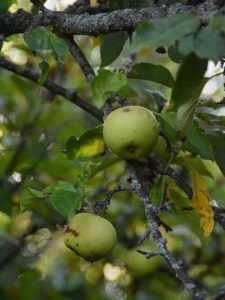 Figure 1. Wild Malus sieversii apples protected in a national park in Kazakhstan. Photo credit: Gayle Volk.
Figure 1. Wild Malus sieversii apples protected in a national park in Kazakhstan. Photo credit: Gayle Volk.
Ex situ conservation is the preservation of plants (specific individuals or populations) in a non-native setting. This includes genebanks (in a field or seedbank), botanic gardens, as well as plant breeding programs. Plants that are conserved ex situ have the advantage of being less vulnerable to environmental and biotic threats, are usually “curated” (cared for), and can be more readily available for research and evaluation. Often, ex situ collections are available for distribution for research and breeding. Information about these collections may be limited by the quality and quantity of documentation of the original plant explorations that brought the plant genetic resources into captivity. Ex situ collections usually conserve plant varieties and cultivars, which don’t exist in the wild, and may also include representatives of wild species.
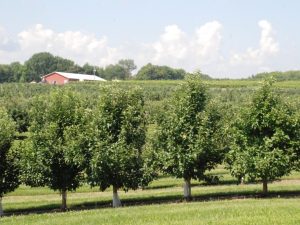 Figure 2. Apple cultivars in the USDA National Plant Germplasm System genebank field collection. Photo credit: Philip Forsline.
Figure 2. Apple cultivars in the USDA National Plant Germplasm System genebank field collection. Photo credit: Philip Forsline.
3. Conservation targets
Plant genebank collections conserve a wide range of diversity, including wild species, landraces, and elite cultivars. Collections are maintained in a variety of forms including seeds, plants in the field, greenhouse, or in vitro, as well as embryos, pollen, cell cultures, and DNA. The desired conservation target and physiology of the species/crop dictate how accessions are maintained in a genebank (Walters et al., 2008).
Seeds and embryos
Most plant genebank collections are maintained primarily as seeds, usually in refrigerated or freezer storage, and sometimes in cryostorage. These collections may represent elite seed-propagated cultivars or highly diverse accessions of seeds collected from wild populations. Seed collections can often be maintained at an optimum moisture content at a reduced temperature for extended lengths of time. When necessary, a subset of the seeds can be used to repropagate the seed collection; this regeneration process must be carefully controlled to ensure that genetic drift, admixture, or unwanted pollinations do not occur. In some cases, embryos excised from seeds may be cryopreserved more successfully than whole seeds.
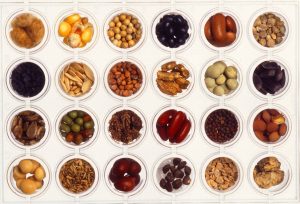 Figure 3. Diverse seeds representing plant materials that may be maintained in a genebank. Photo credit: USDA-ARS.
Figure 3. Diverse seeds representing plant materials that may be maintained in a genebank. Photo credit: USDA-ARS.
Actively growing plants or stored vegetative propagules
Some crops are not propagated by seeds because 1) they don’t produce seeds; 2) specific genetic combinations can only be maintained through clonal propagation (such as by grafting, rooted cuttings, etc); 3) they are dioecious; or 4) it takes a long time to reach reproductive maturity. These types of collections are often referred to as “clonal” or “vegetatively propagated” collections because specific individuals, often in an actively growing state, are maintained for cultivars or species. Many fruit, nut, tuber, and ornamental crops, as well as some vegetables, fall into this category. These clonal collections may be maintained in the field, screenhouse/greenhouse, in vitro, or sometimes as shoot tips or dormant buds in liquid nitrogen. Compared to seed collections, it is generally more expensive (labor and space intensive) to maintain individuals as plants in field collections. In some cases, crop wild relatives of clonally propagated crops could be stored as seeds to capture the genetic diversity of the species.
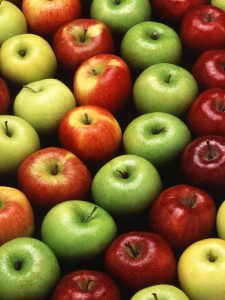 Figure 4. Vegetatively propagated apple cultivars are maintained in genebanks in field collections. Photo credit: USDA-ARS.
Figure 4. Vegetatively propagated apple cultivars are maintained in genebanks in field collections. Photo credit: USDA-ARS.
Pollen
Although pollen is only the male gamete and does not usually represent a regenerable plant, its preservation in genebanks may be particularly useful for breeders. In some cases, pollen may be more readily available and more easily conserved than other propagule types.
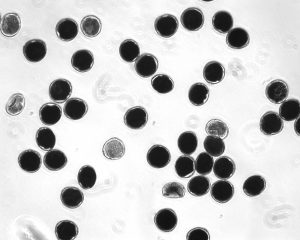 Figure 5. Pecan pollen that has been stained to assess viability (dark pollen grains are alive). Photo credit: John Waddell.
Figure 5. Pecan pollen that has been stained to assess viability (dark pollen grains are alive). Photo credit: John Waddell.
Cells and DNA
Plant cell cultures can sometimes be used to regenerate viable plants. DNA may be genebanked to conserve genetic information.
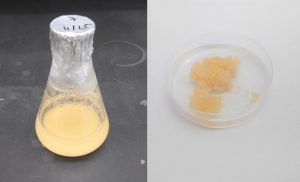 Figure 6. Rice cell cultures that were been recovered after 35+ years of storage in a cryopreserved state. Photo credit: Gayle Volk.
Figure 6. Rice cell cultures that were been recovered after 35+ years of storage in a cryopreserved state. Photo credit: Gayle Volk.
Voucher specimens
Many genebanks are associated with an herbarium collection that provides dried voucher representatives of the original samples. If properly stored, these original samples could last for hundreds of years.
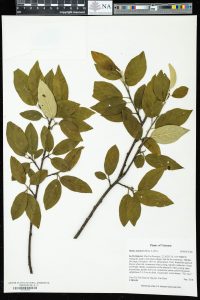 Figure 7. Specimen of Malus fusca from the U.S. National Arboretum Herbarium Collection. Photo credit: USDA National Arboretum.
Figure 7. Specimen of Malus fusca from the U.S. National Arboretum Herbarium Collection. Photo credit: USDA National Arboretum.
4. Considerations for collecting plant genetic resources
Plant genebank collections often include cultivated varieties as well as representatives of wild species. The cultivated varieties may have been originally acquired from research and breeding programs, public gardens, or from conservationists. They may also have been acquired through exchanges with other international, national, or academic genebanks. Wild species can be acquired from similar sources; alternatively, wild species may be collected from their native habitats.
The procurement of wild plant genetic resources requires permission from the landowner, including adherence to relevant national and international regulations and treaties. Often, Material Transfer Agreements (such as the Standard Material Transfer Agreement) are signed to document the legal acquisition of plant materials. Relevant treaties and international agreements include the Convention on Biological Diversity (1992), Nagoya Protocol (2010), and the International Treaty for Plant Genetic Resources for Food and Agriculture (2001). Importation of plant genetic resources into a country is carefully regulated to ensure that pests and pathogens are not spread across international borders. Plant quarantine and plant health inspection services monitor incoming plant materials to ensure that they are sanitary.
The Convention on Biological Diversity (CBD) is a legally-binding multilateral treaty with the goals of 1) the conservation of biological diversity; 2) the sustainable use of its components; and 3) the fair and equitable sharing of benefits arising from the utilization of genetic resources. The CBD entered into force 29 December 1993 and its website is cbd.int.
The Nagoya Protocol on Access to Genetic Resources and the Fair and Equitable Sharing of Benefits Arising from their Utilization to the Convention on Biological Diversity is a legally-binding protocol to the CBD that entered into force on 12 October 2014 (cbd.int/abs). It provides a legal framework to implement the third component of the CBD.
The International Treaty for Plant Genetic Resources for Food and Agriculture (IT PGRFA) is a legally-binding international agreement. “The objectives of this Treaty are the conservation and sustainable use of plant genetic resources for food and agriculture and the fair and equitable sharing of the benefits arising out of their use, in harmony with the Convention on Biological Diversity, for sustainable agriculture and food security.” The treaty’s Multilateral System of Access and Benefit-sharing covers 64 food crops and forages and contains provisions addressing issues such as farmer’s rights, access and benefit sharing, and ex situ collections.
The identification, selection, and acquisition of plant materials for genebank conservation is complicated. Specific information about these processes is provided elsewhere (Chapter in progress).
5. Retaining diversity in genebanks
Ideally, the genebanking process should not substantially alter the genetic composition of the original sample, whether it be a specific variety or collected from the wild. This requires careful control of each step in the genebanking procedure, to ensure that:
- Seeds or plants remain viable as long as possible in the conserved state
- Regeneration efforts do not cause substantial genetic drift
Video 1. How do you capture the diversity of crop wild relatives in a genebank?
Video 2. How do you retain the diversity of crop wild relatives in a genebank?
6. International efforts to conserve Crop wild relatives
The Crop Trust is an international organization that has recognized the need to conserve crop wild relatives at an international scale. It conducts a project titled “Adapting agriculture to climate change: Collecting, protecting and preparing crop wild relatives” with objectives to collect important species of crop wild relatives, ensure their long-term conservation, and facilitate their use in breeding new, improved crops. The project focuses on 29 priority crops. Collection trips are being performed with 24 country partners and prebreeding efforts involve 53 national and international partners. The project has developed a number of resources available with regard to crop wild relative inventories, collecting guidelines, gap analyses, and prebreeding that are available at the following website: cwrdiversity.org.
Video 3. International efforts to conserve crop wild relatives.
7. Conserving seeds of wild species
In general, seeds of cultivars are often conserved more easily in genebanks than are those of wild species. Plant cultivars, particularly those of seed-cultivated crops, have usually undergone a domestication process that makes the seeds more amenable to genebank preservation. Domesticated seeds often have a more uniform maturity, less shattering (seed drop), loss of photoperiod sensitivity, and altered dormancy characteristics (more able to withstand desiccation and cold storage or have lost their seed dormancy). They are also more uniform with respect to size, shape, and physiological traits.
Video 4. Why are the seeds of crop wild relatives difficult to maintain in a genebank?
8. References
Bretting PK, Duvick DN. 1997. Dynamic conservation of plant genetic resources. Advances in Agronomy 61:1-51.
Dulloo ME, Hunter D, Borelli T. 2010. Ex situ and in situ conservation of agricultural biodiversity: Major advances and research needs. Notulae Botanicae Horti Agrobotanici Cluj-Napoca 38:123-135.
Walters CW, Volk GM, Richards CM. 2008. Genebanks in the post-genomic age: Emerging roles and anticipated uses. Biodiversity 9:68-71.
9. Acknowledgments
Citation: Volk GM, Richards C, Walters C, Dempewolf H, Byrne P. 2020. Crop Wild Relatives in Genebanks. In: Volk GM, Byrne P (Eds.) Crop Wild Relatives in Genebanks. Fort Collins, Colorado: Colorado State University. Date accessed. Available from https://colostate.pressbooks.pub/cropwildrelatives/chapter/crop-wild-relatives-in-genebanks/
This training module was made possible in part by funding from USDA-ARS, Colorado State University, IICA-PROCINORTE (procinorte.net), and the United States Agency for International Development (USAID).
Chapter editors: Emma Balunek, Katheryn Chen, Gayle Volk
Videographers: Mike May, Michael Major
This project was funded in part by the National Academy of Sciences (NAS) and USAID, and any opinions, findings, conclusions, or recommendations expressed in such are those of the authors alone, and do not necessarily reflect the views of USAID or NAS.


